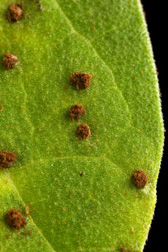This page has been archived and is being provided for reference purposes only. The page is no longer being updated, and therefore, links on the page may be invalid.
Discovery May Solve Devastating Rust Fungus Issue for Bean Growers
By Alfredo FloresFebruary 27, 2009
The detection of 3,000 proteins produced in plants of common beans could help breeders develop resistance against the bean rust fungus, Uromyces appendiculatus, a major concern for domestic dry bean and snap bean growers. This rust is prevalent throughout the continental United States, according to research by Agricultural Research Service (ARS) scientists and cooperators.
Plant pathologist Bret Cooper, at the ARS Soybean Genomics and Improvement Laboratory (SGIL) in Beltsville, Md., leads the research, which could help scientists determine which proteins produced in bean plants are involved in providing resistance to rust fungus.
The symptoms of this rust initially appear as small white flecks on the upper leaf surface, then develop into reddish-brown pustules (small eruptions on the leaf surface). When severe infections occur, the leaves curl upward, dry, turn brown, and drop prematurely, and pod set, pod fill and seed size are reduced.
To make matters worse, in 2004, a separate rust fungus that causes Asian soybean rust—which infects soybeans, but not common beans—arrived in the United States. Domestic soybean cultivars have little resistance to soybean rust, and now America's second largest crop is severely threatened by this new disease. It is hoped that the discovery of the dry bean rust disease resistance proteins will help identify similar proteins in soybeans and advance soybean breeding efforts as well.
Until recently, disease resistance genes and the proteins they produce were studied one at a time, but Cooper and his team used a process called high-throughput mass spectrometry to identify, at a much faster rate, proteins by their unique molecular mass. With this technology, they evaluated more than 3,000 rust resistance proteins in bean over the course of two-and-a-half years, and measured how protein levels change in plants, and which ones provide disease resistance.
This study revealed more than 1,500 “molecular battles”— interactions between the fungus and the plant—and led to the identification of a potential set of proteins thought to be master regulators of a strong resistance response in the plant. This new information may help breeders improve bean varieties that are currently threatened by rust.
The scientific team also includes molecular biologist Mark Tucker, plant physiologist Kimberly Campbell, and bean breeder Talo Pastor-Corrales at SGIL, as well as molecular biologist Brian Scheffler at the Mid South Area Genomics Laboratory in Stoneville, Miss. Other collaborators include scientists at Johns Hopkins University in Baltimore and the University of Missouri in Columbia.
The research was published recently in Molecular and Cellular Proteomics.
ARS is the principal intramural scientific research agency in the U.S. Department of Agriculture.

